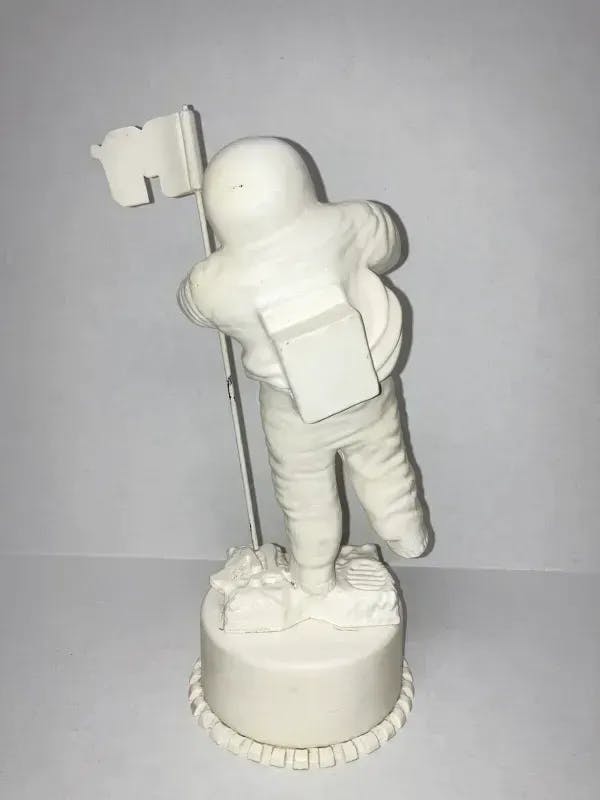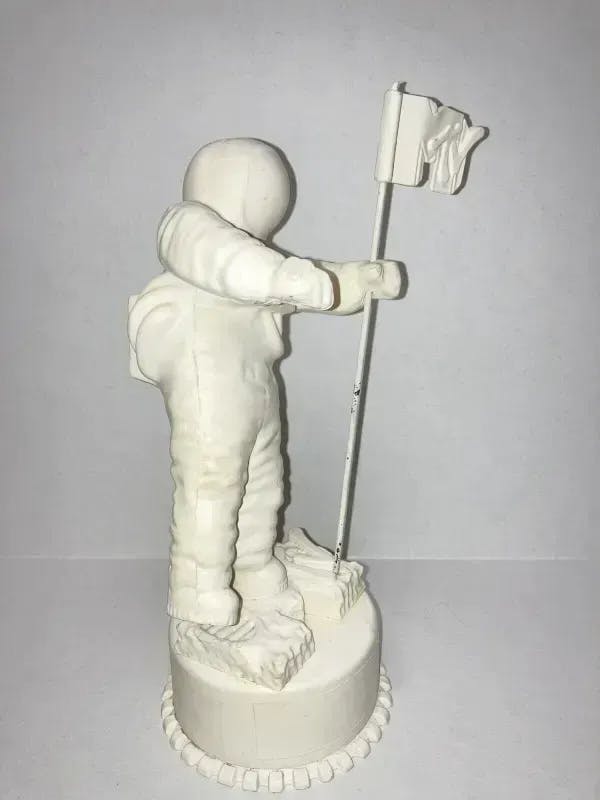AQ.0003
Pat Gorman:
MTV Video Music Awards Moonman Prototype (1984)
Award prototype
•
Acquired Jul 2022
Space Jams
In June, 1984, MTV announced that it would host the very first Video Music Awards. Conceived as an alternative to the Grammy’s, the award show would celebrate the top videos of the year. The idea was that the show would be energetic and unpredictable, matching MTV’s vibe at the time, and Dan Aykroyd and Bette Midler were chosen to be the first hosts. The network still needed a fitting trophy, however, so they turned to Manhattan Design, a design collective based out of New York City. Three trophy designs were proposed – a sneaker, a bucket of popcorn and a Moonman, with the Moonman being the first choice of Pat Gorman, the designer tasked with creating the award. In her words:
With just under two weeks until the first VMAs, the network agreed with Gorman that the Moonman would be the official trophy. In a flurry of rushed design, the Moonman went through several iterations, including a “horrible” (per Gorman) design featuring an astronaut wearing bell bottoms, and another with both feet planted on the ground. With time running out, Gorman finally decided to sculpt the trophy herself, this time sans bell bottoms and with one foot up in the air.
“The whole idea was, the statue had to be balancing on one leg, like anti-gravity and floating,” Gorman said. “Otherwise, it didn’t have any magic to it.”
The trophy also included a footprint at its base, an homage to Neil Armstrong’s famous quote, a quote which was altered and included in the show – “This is one small step for man, but a giant step for all music.”
Given the short time frame, Gorman was only able to finish five trophies. So the producers came up with (what they thought was) a brilliant idea – they would present just five awards, cut to commercial, retrieve the five awards from the winners, and present them again to the next winners! All was going according to plan until Diana Ross threw a wrench in the whole scheme. Ross, seated in the front row, was collecting all of Michael Jackson’s awards on his behalf and kept bringing them back to her seat. When a crew member attempted to retrieve them, she wouldn’t give them up.
According to Gorman, who was in the audience that night, “Somehow they didn’t communicate with the cameramen, so when we came back from commercial, Diana Ross and this backstage guy were involved in a tug of war over the statues… We turned around and we waved at the cameraman frantically to say, ‘Stop, stop, go to commercial!’ So they went to commercial almost immediately, and somebody explained it to [Ross], and even then she really didn’t want to give them up. It was somewhere between really terrible and really hilarious; it was just so insane. I thought, ‘This is the award show where anything happens, and it’ll always be that way.’”
Unpredictable as the VMAs may be, the Moonman statue has been a mainstay. It has, however, evolved a bit from its early days. In 2013 the artist KAWS redesigned the statue (with that year’s award show featuring a 60 foot tall inflatable version of it on stage) and in 2015 the designer Jeremy Scott gave it a ‘90s makeover. From its early days, frantically hand-sculpted by Pat Gorman, to its iconic cultural status today, the Moonman statue is one of the most coveted awards in entertainment.
Details
Meet Pat Gorman & Manhattan Design

Pat Gorman is one of the most influential pop culture designers and, whether you know her name or not, you’ve most certainly seen her work.
Born in 1947 and raised in Whitestone, New York, Gorman was co-founder of Manhattan Design, one of the most innovative graphic design collectives of the twentieth century. In 1980, operating out of a tiny room in the back of a Greenwhich loft, the collective was approached by MTV’s creative director to come up with a logo. After hundreds of preliminary sketches, Gorman landed on the now iconic “M’ in bold 3D sans serif. Her co-founder Frank Olinsky then took a large version of the “M” into their studio’s stairwell, spray painted a “TV” next to it and, paint drips and all, presented it to the network. The network couldn’t have been more pleased, and the rest is, as they say, history.
With the logo complete, MTV now asked Gorman and Manhattan Design to develop the first broadcast. Airing just after midnight on August 1, 1981, MTV’s first broadcast was a literal launch – featuring video of a space shuttle taking off, a man on the moon with an MTV flag, and a voice-over proclaiming “Ladies and gentleman – Rock and Roll.” According to Gorman, the iconic logo and moon landing was inspired by “claiming uncharted territory…“We thought, ‘We’re like the guys landing on the moon and claiming it. We claim this land for music…The thing about music is, there’s always something happening that’s the next thing. There’s always something new. MTV was claiming that. The Moonman claims all of that: what has happened and what will become in music.”
With the success of this early work, Gorman and Manhattan Design would go on to create MTV’s “top of the hour” animation, a short video that played every hour of every day for nearly four years, a total of 75,000 times. Gorman also designed many of MTV’s popular souvenir items, like shirts and hats, numerous sets for the Video Music Awards and of course the most coveted trophy in entertainment – The Moonman.
In addition to her work for MTV, Gorman also designed album covers for some of the top musical acts of the day, including The Talking Heads, Billy Idol, Duran Duran, The Cars, The B-52s and many more. She has earned many awards, including a Clio and Video Music Award, and has been a keynote speaker at AIGA events. She was included in The New York Times Magazine’s list of the 100 most influential designs of the century and has been featured in Graphis, Billboards, TIME and Art Director Magazines.
Gorman, along with her co-founders at Manhattan Design, are nearly single-handedly responsible for the first visual designs of MTV, designs that would set off a Cambrian explosion of culture, forever altering the landscapes of music, community and technology.
Artist
Electric Dreams
The music video is one of the most inescapable yet undeniably influential forms of media in the 21st century. From Tupac to Whitney, Madonna to Nirvana, it became a vehicle through which commercialism, creativity, and technology clashed to produce cultural moments – televised “total works of art,” complete with their own aesthetic and vernacular references, that replicated themselves in living rooms all over the world.
We took a look back at some key moments in music television history from the turn of the century (1980-2000) to consider objects that capture and communicate the complex shifts that happened at this time. How does music (and the fashion, attitudes, and economies that form around it) create new communities of belonging? How did music videos spur creative and technological innovations? How did key players, like Madonna, MJ, or Missy Elliott innovate within and beyond the bounds of the medium? In a time before Spotify, iPhones, and TikToks, what electric dreams did music videos conjure, and what future did they foretell?
Arkive launched an acquisition round titled “Electric Dreams” on July 18, 2022, engaging in dialogue, discussion, and debate to choose which work to acquire. The Moonman Prototype was considered alongside Madonna’s “Like A Prayer” Pulled Pepsi Commercial original VHS tape, two works telling the story of music television’s impact on pop culture.
After a series of votes, the community selected the Moonman Prototype as the third acquisition into the collection. Core team members then worked with a private collector to acquire the work. The Moonman Prototype will go on display globally via an Arkive traveling exhibition in late 2022. Following that, the work will enter into long term residency at a prominent public location, as selected by the Arkive membership.






